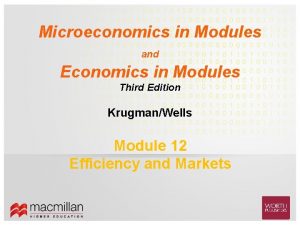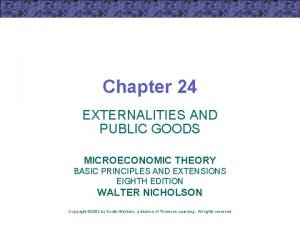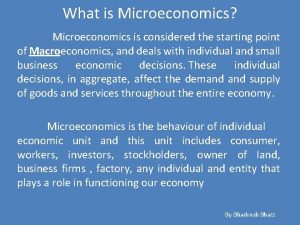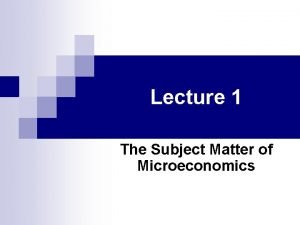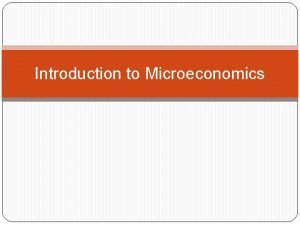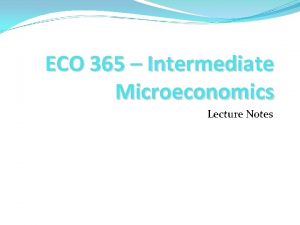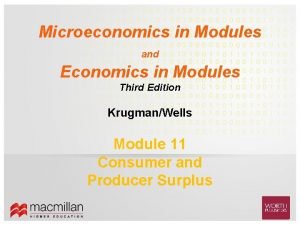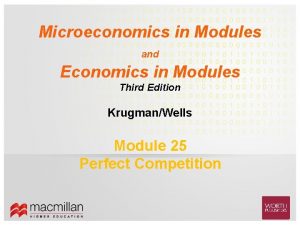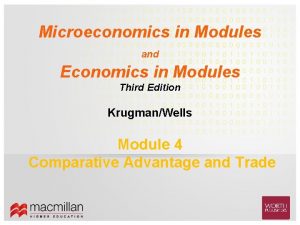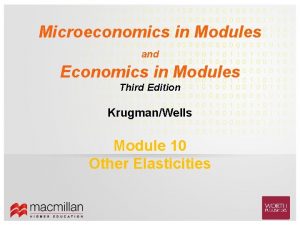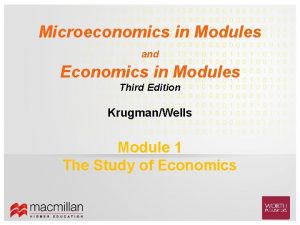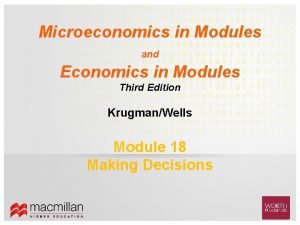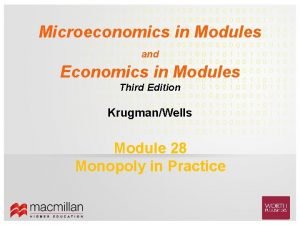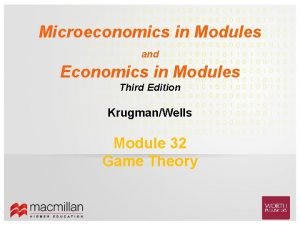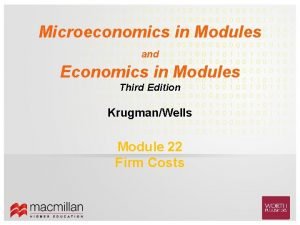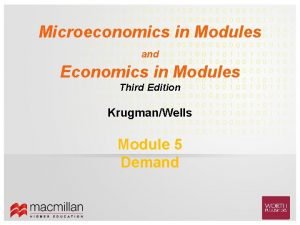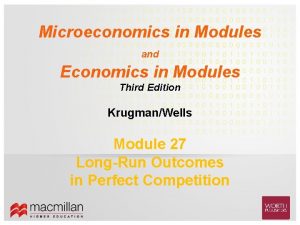Microeconomics in Modules and Economics in Modules Third













- Slides: 13

Microeconomics in Modules and Economics in Modules Third Edition Krugman/Wells Module 23 Long-Run Costs and Economies of Scale

What You Will Learn 1 Why a firm’s costs may differ between the short run and the long run 2 How the firm’s technology of production can generate increasing returns to scale 2 of 12

Short-Run versus Long-Run Costs • In the short run, fixed cost is completely outside the control of a firm. • But all inputs are variable in the long run, so that in the long run fixed cost may change. 3 of 12

Short-Run versus Long-Run Costs • In the long run, in other words, a firm’s fixed cost becomes a variable cost it can choose. • The firm will set its fixed cost in the long run according to the level of output it expects to produce. 4 of 12

Choosing the Level of Fixed Cost of Selena’s Gourmet Salsas Cost of case $250 At low output levels, low fixed cost yields lower average total cost. At high output levels, high fixed cost yields lower average total cost 200 150 Low fixed cost ATC 1 100 ATC 2 High fixed cost 50 0 1 2 3 4 5 6 7 8 9 10 There is a trade-off between higher fixed cost and lower variable cost for any given output level, and vice versa. But as output goes up, average total cost is lower with the higher amount of fixed cost. Quantity of salsa (cases) High fixed cost (FC = $216) Low fixed cost (FC = $108) Quantity Average High Low Total of salsa variable total cost variable cost total cost of case cost (cases) cost 1 2 3 4 5 6 7 8 9 10 $120 48 108 192 300 432 588 768 972 1, 200 156 216 300 408 540 696 876 1, 080 1, 308 $120. 00 78. 00 72. 00 75. 00 81. 60 90. 00 99. 43 109. 50 120. 00 130. 80 $6 24 54 96 150 216 294 384 486 600 $222 240 270 312 366 432 510 600 702 816 $222. 00 120. 00 90. 00 78. 00 73. 20 72. 00 72. 86 75. 00 78. 00 81. 60 5 of 12

The Long-Run Average Total Cost Curve • The long-run average total cost curve shows the relationship between output and average total cost when fixed cost has been chosen to minimize average total cost for each level of output. 6 of 12

Short-Run and Long-Run Average Total Cost Curves Cost of case Constant returns to scale Increasing returns to scale Decreasing returns to scale ATC 3 ATC 6 ATC 9 LRATC B Y A 0 X C 3 4 5 6 7 8 9 Quantity of salsa (cases) 7 of 12

Returns to Scale • There are increasing returns to scale (economies of scale) when long-run average total cost declines as output increases. 8 of 12

Returns to Scale • There are decreasing returns to scale (diseconomies of scale) when long-run average total cost increases as output increases. 9 of 12

Returns to Scale • There are constant returns to scale when longrun average total cost is constant as output increases. 10 of 12

Economics in Action There’s No Business like Snow Business • Washington, D. C. , and Chicago are like two businesses with different expectations about output (snow removal). • Therefore, they make different decisions about the level of fixed cost. 11 of 12

Summing Up Costs 12 of 12

Summary 1. In the long run, a producer can change its fixed input and its level of fixed cost. The long-run average total cost curve shows the relationship between output and average total cost when fixed cost has been chosen to minimize average total cost at each level of output. 2. As output increases, there are increasing returns to scale if long-run average total cost declines; decreasing returns to scale if it increases; and constant returns to scale if it remains constant. Scale effects depend on the technology of production. 3. A sunk cost is a cost that has already been incurred and is not recoverable. A sunk cost should be ignored in a decision about future actions. 13 of 12
 Economics modules
Economics modules Gj mount classification of dental caries
Gj mount classification of dental caries Gingival third vs cervical third
Gingival third vs cervical third Maastricht university economics and business economics
Maastricht university economics and business economics Principles of economics oxford fajar
Principles of economics oxford fajar Externalities and public goods microeconomics
Externalities and public goods microeconomics Macroeconomics vs microeconomics venn diagram
Macroeconomics vs microeconomics venn diagram Micro macro economics
Micro macro economics Mathematical economics vs non mathematical economics
Mathematical economics vs non mathematical economics Copy
Copy What is the subject matter of microeconomics
What is the subject matter of microeconomics Significance of microeconomics
Significance of microeconomics Intermediate microeconomics lecture notes
Intermediate microeconomics lecture notes Intermediate microeconomics notes
Intermediate microeconomics notes
